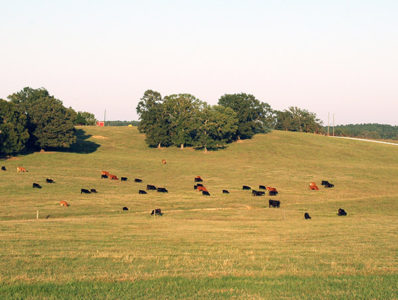Supplement Dry Fall Grazing With Small-grain Crops
 Supplement Dry Fall Grazing With Small-grain Crops
Supplement Dry Fall Grazing With Small-grain Crops
by Duane Dailey, University of Missouri Extension
Seeding winter annual small grain offers fall grazing for beef cow herds short on grass and hay.
“Lots of calls are coming in,” said Craig Roberts, University of Missouri (MU) Extension forage specialist. He offers encouraging words and cautions.
Drilling wheat, cereal rye or oats can provide forage. Seeded in the fall, the grain crops become annual grass pasture for fall and winter. They supply quick grazing when fall rains return. Wheat and rye also provide more forage early next spring. “If you have a good stand of fescue or alfalfa, don’t drill grain seedings on that land. Annual grain crops should be seeded only on weak pastures,” Roberts said. “There should be plenty of those this year.”
Rob Kallenbach, MU forage specialist, cautioned that he has seeded winter grains into strong stands of fescue in his research. “All failed,” he added. “Fescue sod makes strong competition.” Farmers should use caution seeding into an alfalfa field. “The cost of getting alfalfa seeded must be protected. Seed only into weak alfalfa stands that need renovation,” Roberts said. Cereal rye remains winter-hardy with quick regrowth next spring. The weaker oats give good fall growth but fade over winter. That leaves land open in spring for planting crops or seeding pastures.
This year needs extra attention to stockpiling fescue pastures for winter grazing, according to specialists. “If there was ever a year to apply fall nitrogen, this is it,” said John Lory, MU Extension soil specialist. “You’ll get a big bang for your buck.” High-price hay makes grazing forage a cost cutter. Fall pasture care includes clipping stemmy fescue seedheads to encourage regrowth. In normal years this includes grazing down to 3 inches. However, in drought areas most grass leaves are already too short. Winter pasture stockpile needs 40 to 50 pounds of nitrogen fertilizer per acre. This should go on before fall rains, which usually begin in September.
An MU field staff member added that fall-applied nitrogen won’t be wasted if rains don’t come. Fertilizer will still be there for spring growth. Usually spring nitrogen isn’t needed. If it doesn’t rain, spring forage becomes worth even more. “All plans for fall grass growth depend on return of rains.” Roberts says. “Just assume rains will come. They usually do.”
Farmers recall the drought of 2012. An extreme summer drought that year broke when big rains came the first week of September. Remnants of a Gulf Coast hurricane soaked much of the state. That rain restored grasses and made a soybean crop. Droughts do end.



